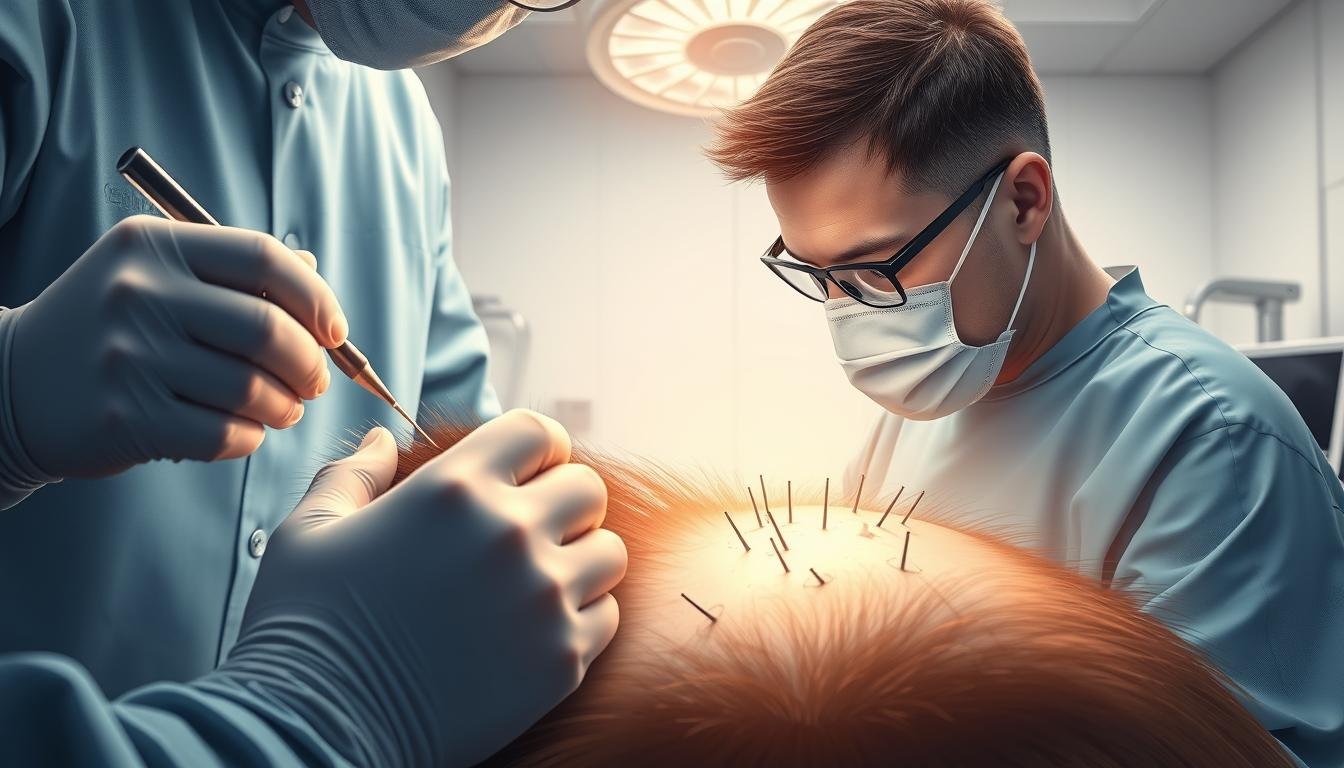Are you struggling with hair loss that affects your self-confidence? You’re not alone. Many individuals face the challenge of balding or thinning hair, impacting their overall well-being. Fortunately, advancements in medical technology have made it possible to address this issue effectively.
A hair transplant is a reliable solution for those experiencing hair loss. This procedure involves transferring hair follicles from donor areas to recipient areas where hair growth is sparse or non-existent. With modern techniques, the results can be remarkably natural-looking, significantly improving one’s appearance and confidence.
At our clinic in Al Ain, we offer comprehensive hair transplant treatments tailored to individual needs. Our experienced team is dedicated to providing the best possible outcome, ensuring a successful treatment with lasting results.
Key Takeaways
- Permanent solution for hair loss, balding, or thinning hair
- Natural-looking results from modern hair transplant techniques
- Customized treatment plans for each patient
- Cost ranges from AED6000 to AED14000, depending on the technique and extent of treatment
- High success rate with long-lasting results for suitable candidates
Understanding Hair Transplantation
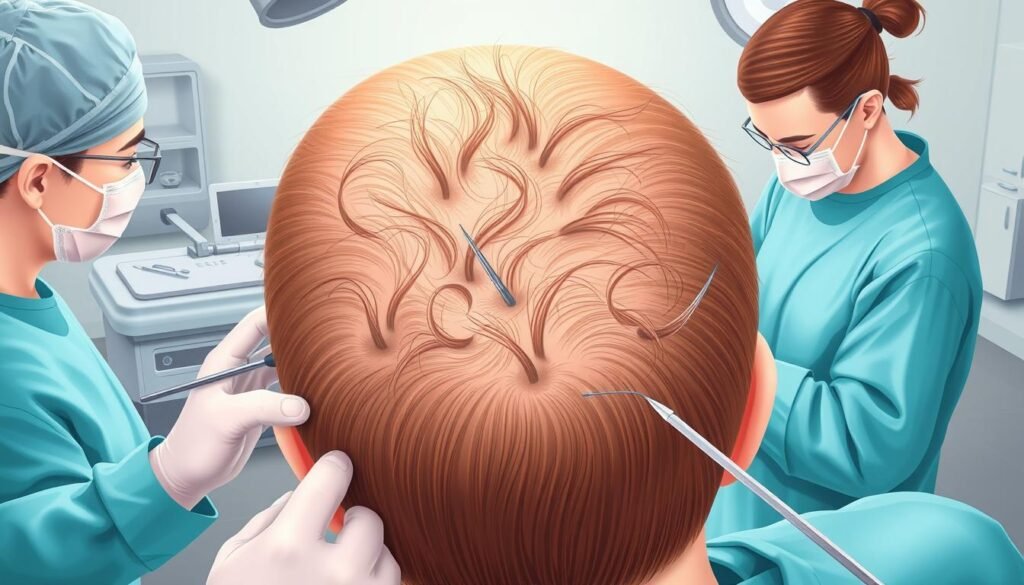
Hair transplantation is a surgical technique that has evolved significantly, providing natural-looking results for those affected by hair loss. It involves relocating hair follicles from a donor site, typically the back or sides of the head, to areas experiencing balding or thinning.
The science behind hair transplantation relies on the principle that hair follicles from the donor area are genetically resistant to the hormones that cause hair loss. Modern hair transplant methods have refined the procedure to provide more natural results.
- Hair transplantation is a surgical procedure that involves relocating hair follicles.
- The method chosen for transplantation depends on various factors.
- Understanding the biological process of hair growth cycles is essential.
For more information on specific techniques like FUE hair transplant, visit our detailed guide.
Hair Transplant in Al Ain: An Overview
With state-of-the-art clinics, Al Ain is emerging as a leading choice for hair transplantation in the UAE.
The city’s clinics offer comprehensive hair restoration services, utilizing the latest technologies and techniques. Experienced surgeons provide personalized treatment plans tailored to each patient’s needs.
- Advanced facilities ensure safe and effective procedure outcomes.
- Clinics follow international standards for hair transplant treatments.
Enfield Royal, a trusted clinic, is located at the junction of AlThanya and Al Wasi Road. The results are promising, making Al Ain a preferred destination for hair transplant procedures.
Common Causes of Hair Loss
Understanding the causes of hair loss is crucial for finding the right treatment. Hair loss, or alopecia, can significantly affect an individual’s self-esteem and mental health.
The receding hairline and balding spots are common issues that can be addressed through hair transplant in Al Ain, a procedure that involves relocating follicular units from one part of the body to another.
Several factors contribute to hair loss, including:
- Androgenetic alopecia, or male and female pattern baldness, affecting up to 50% of men by age 50 and many women after menopause.
- Hormonal changes due to pregnancy, childbirth, menopause, or thyroid problems, leading to temporary or permanent hair loss.
- Stress, both physical and emotional, causing telogen effluvium, a condition where hair enters the resting phase prematurely.
- Medical conditions like alopecia areata, scalp infections, and trichotillomania.
- Certain medications and treatments for conditions such as cancer, arthritis, and depression.
- Nutritional deficiencies, particularly of iron, protein, and vitamins, impacting hair health.
- Hairstyling practices that damage hair follicles, such as tight ponytails and braids.
| Cause | Description | Impact on Hair |
|---|---|---|
| Androgenetic Alopecia | Genetic condition leading to pattern baldness | Permanent hair loss |
| Hormonal Changes | Changes due to pregnancy, menopause, or thyroid issues | Temporary or permanent hair loss |
| Stress | Physical or emotional stress | Telogen effluvium, leading to hair fall |
As highlighted by a study, “Hair loss can be a source of significant distress for both men and women, affecting their quality of life and self-esteem.” Understanding the underlying cause is key to determining the appropriate treatment, such as a hair transplant.
Hair Transplant Techniques Available in Al Ain
Al Ain offers a range of advanced hair transplant techniques, catering to diverse needs and preferences. These methods have evolved significantly, providing effective solutions for hair loss.
FUE (Follicular Unit Extraction)
FUE is a modern hair transplantation technique that involves extracting individual follicles from the donor site using a specialized tool. This method leaves minimal scarring and allows for a quicker recovery. It’s particularly beneficial for those who prefer a shorter haircut.
FUT (Follicular Unit Transplantation)
FUT, also known as strip harvesting, involves removing a strip of hair-bearing skin from the back of the head. The extraction of individual follicular units from this strip follows, which are then transplanted to the balding areas. This procedure is effective for larger balding areas.
DHI (Direct Hair Implantation)
DHI is an advanced technique that involves extracting and implanting hair follicles in a single session. It uses a specialized tool to create recipient sites and implant grafts simultaneously, minimizing handling of the grafts and potentially improving survival rates.
Robotic Hair Transplantation
Robotic hair transplantation utilizes artificial intelligence and robotic technology to assist surgeons in performing FUE procedures. The ARTAS system is a commonly used robotic platform that offers high-definition imaging and precise follicle extraction. Key benefits include:
- Enhanced precision in graft extraction and placement
- Reduced fatigue-related errors during lengthy procedures
- Improved graft survival rates due to minimized handling
- Particularly beneficial for patients with curly or wavy hair
The Hair Transplant Procedure Step by Step
The hair transplant procedure is a multi-step process that requires precision and expertise. It involves several stages, from initial consultation to the actual transplantation process, ensuring that the patient achieves the best possible results.
Initial Consultation
The journey begins with an initial consultation, where the surgeon assesses the patient’s hair loss and discusses their goals. This step is crucial in determining the most suitable technique for the transplant, such as FUE, FUT, DHI, or Robotic hair transplantation.
Preparation Before Surgery
Preparation before surgery is vital for a successful transplant. This includes administering local anesthesia to both the donor and recipient areas to ensure patient comfort. The donor area is prepared according to the chosen technique, which may involve shaving or trimming a strip of hair.
The Transplantation Process
The transplantation process involves extracting follicular units from the donor area using the chosen technique. The harvested grafts are then sorted and preserved in a special solution. The surgeon creates recipient sites in the balding area, considering the natural hair growth pattern, angle, and density. Grafts are meticulously placed into these sites, with attention to the hairline design for a natural appearance. As noted by a renowned hair restoration expert,
“The art of hair transplantation lies in the precise placement of grafts to mimic natural hair growth.”
The number of grafts transplanted can range from 1,000 to 4,000 per session, depending on the extent of hair loss and patient goals.
Cost of Hair Transplant in Al Ain
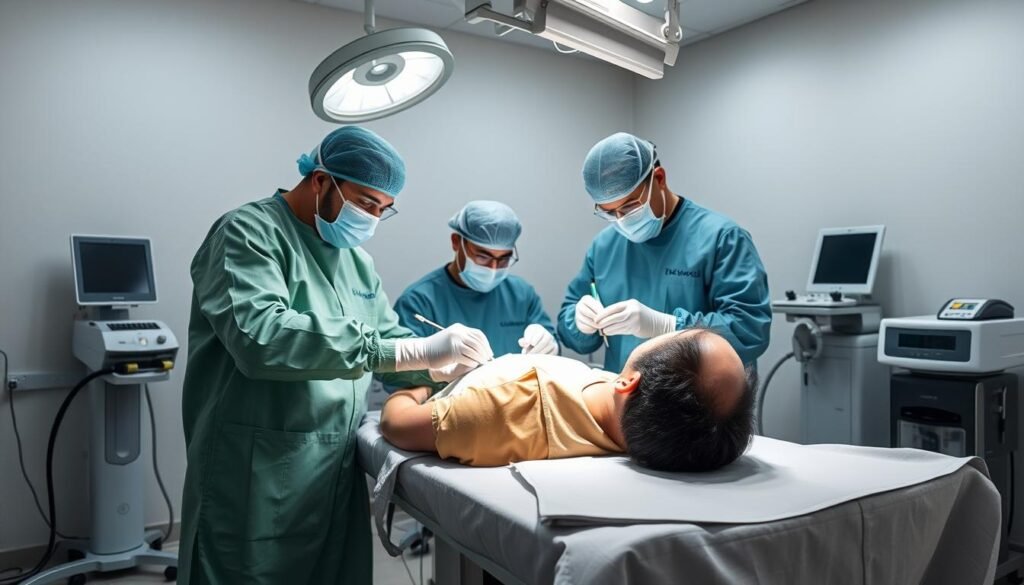
Hair transplant costs in Al Ain can vary significantly based on several factors. The cost is influenced by the technique used, the extent of the treatment required, and the expertise of the surgeon.
Factors Affecting the Cost
The cost of a hair transplant is determined by several key factors, including the technique employed, the number of grafts required, and the clinic’s reputation. Additionally, the experience and qualifications of the surgeon can impact the overall cost. Patients should also consider the quality of care and the technology used.
Payment Options and Insurance Coverage
Most hair transplant procedures are considered cosmetic and are not covered by standard health insurance plans. However, some clinics in Al Ain offer flexible payment plans to help patients manage the cost of treatment. The average cost is quoted in AED, making it essential for international patients to inquire about currency exchange rates.
- Most hair transplant procedures are considered cosmetic and therefore not covered by standard health insurance plans.
- Some clinics in Al Ain offer interest-free installment plans to help patients manage the cost of treatment over time.
- Credit card payments, bank transfers, and cash are typically accepted by most hair transplant clinics in the region.
- In rare cases where hair loss is due to trauma or medical conditions, partial insurance coverage may be possible with proper documentation.
- Some clinics offer package deals that include all aspects of treatment at a reduced total cost compared to paying for services separately.
- International patients may be offered special rates or packages that include accommodation and transportation arrangements.
- It’s advisable for patients to inquire about hidden costs and ensure all aspects of treatment are included in the quoted price.
Recovery and Aftercare
The journey to a fuller head of hair doesn’t end with the transplant procedure; proper aftercare is essential. Ensuring the success of your hair transplant involves a careful recovery and aftercare regimen.
Immediate Post-Procedure Care
After the hair transplant, the initial healing phase is critical. Patients may experience a period known as “shock loss” where transplanted hairs shed within 2-4 weeks. This is a normal part of the hair growth cycle and not a cause for concern. New growth typically begins within 3-4 months.
Immediate care involves following the surgeon’s instructions to minimize complications and ensure the best possible outcome. This includes gentle washing and avoiding strenuous activities.
Long-term Hair Care After Transplantation
For long-term success, it’s crucial to maintain a healthy diet rich in proteins, vitamins, and minerals to support optimal hair growth. Using gentle, sulfate-free hair products and avoiding harsh chemicals or treatments for at least 6 months is recommended. Protecting the scalp from sun exposure with hats or sunscreen is also important.
| Timeframe | Care Instructions | Expected Outcome |
|---|---|---|
| 1-3 months | Gentle washing, avoid strenuous activities | Shedding of transplanted hair |
| 3-4 months | Maintain healthy diet, gentle hair products | New hair growth begins |
| 9-12 months | Continue healthy diet, protect scalp from sun | Full results visible |
Regular check-ups with the surgeon at 3, 6, and 12 months are recommended to monitor progress. Some surgeons may also suggest supplementary treatments like low-level laser therapy or PRP to enhance results. Over time, the transplanted hair lasts for a long time and is usually permanent, with full results seen after several months.
Timeline of Results
After undergoing a hair transplant, patients often wonder when they can expect to see the final results. The hair transplant process involves several stages, with the final outcome being a natural-looking hair growth.
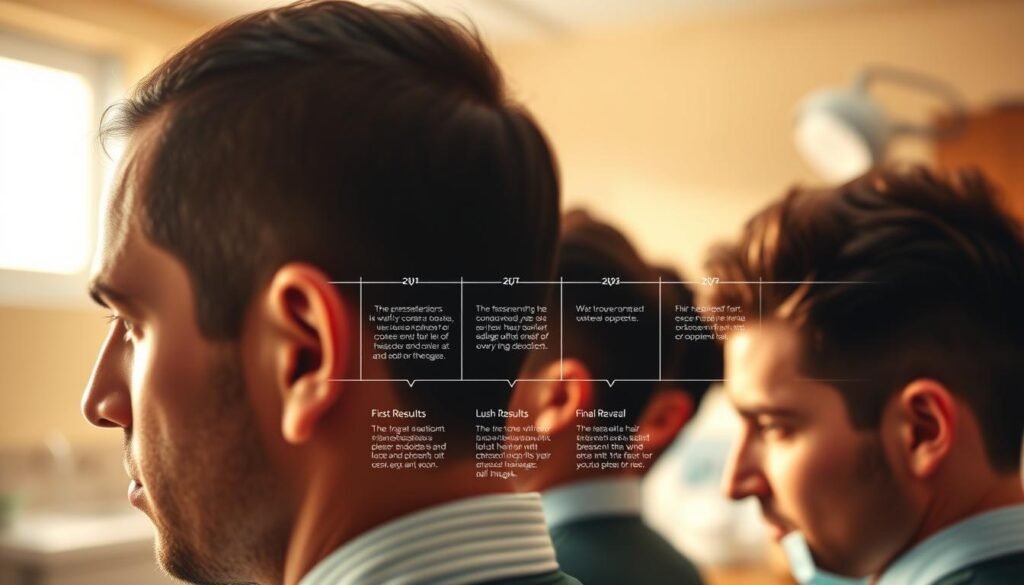
The results of the method generally last for a lifetime. However, some candidates might observe hair thinning in non-transplanted areas, necessitating additional treatments or non-surgical hair loss treatments to maintain overall appearance.
What to Expect in the First Few Months
In the initial months following the procedure, the body undergoes various changes. Between 6-9 months, hair density increases significantly as more transplanted follicles enter the active growth phase. By 9-12 months, the texture and thickness of new hair improve, providing a more complete and natural appearance.
- Hair density increases between 6-9 months.
- Texture and thickness improve by 9-12 months.
Final Results and Longevity
The final results of a hair transplant are typically visible by the one-year mark, with most patients achieving 80-90% of their final results. The transplanted hair is permanent and will continue to grow throughout the patient’s lifetime, although it may thin somewhat with age. To maintain the results, patients may need to undergo additional treatments or medications to prevent further hair loss.
- Final results are visible by 12 months.
- Transplanted hair grows throughout a patient’s lifetime.
Potential Side Effects and Risks
While hair transplantation is a relatively safe procedure, it’s crucial for patients to be aware of the potential side effects and risks involved.
The side effects of hair transplantation can be temporary or, in some cases, more persistent. Common issues include swelling, redness, and discomfort at both the donor and recipient sites.
- Temporary side effects typically resolve within a week.
- Infection is a rare but possible complication that can be prevented with proper aftercare.
- Pain during or after the procedure may occur but is usually minimal.
- Shock loss, or the temporary shedding of existing hair, can occur but typically resolves as new growth emerges.
It’s essential for the patient to follow post-instructions carefully to minimize the risk of complications. By understanding the potential effects and taking necessary precautions, patients can ensure a smoother recovery.
| Potential Side Effects | Description | Duration |
|---|---|---|
| Swelling and Redness | Common reactions at the donor and recipient sites | Typically resolves within a week |
| Infection | Rare but possible complication | Can be treated with antibiotics |
| Pain | Minimal discomfort during or after the procedure | Usually controlled with medication |
Benefits of Hair Transplantation
The benefits of hair transplantation extend far beyond aesthetic improvements, providing a lifetime solution to hair loss. This procedure not only restores a full head of hair but also boosts the patient’s self-esteem and confidence.
Some key advantages include natural-looking results, a permanent solution with transplanted hair behaving like natural hair, and improved psychological well-being.
| Benefits | Description |
|---|---|
| Natural-Looking Results | Transplanted hair grows and behaves like natural hair. |
| Permanent Solution | Hair transplantation provides a long-lasting solution to hair loss. |
| Improved Confidence | Patients experience significant psychological benefits. |
For more information on hair transplantation and to schedule a consultation, visit Enfield Abu Dhabi’s Hair Transplant page.
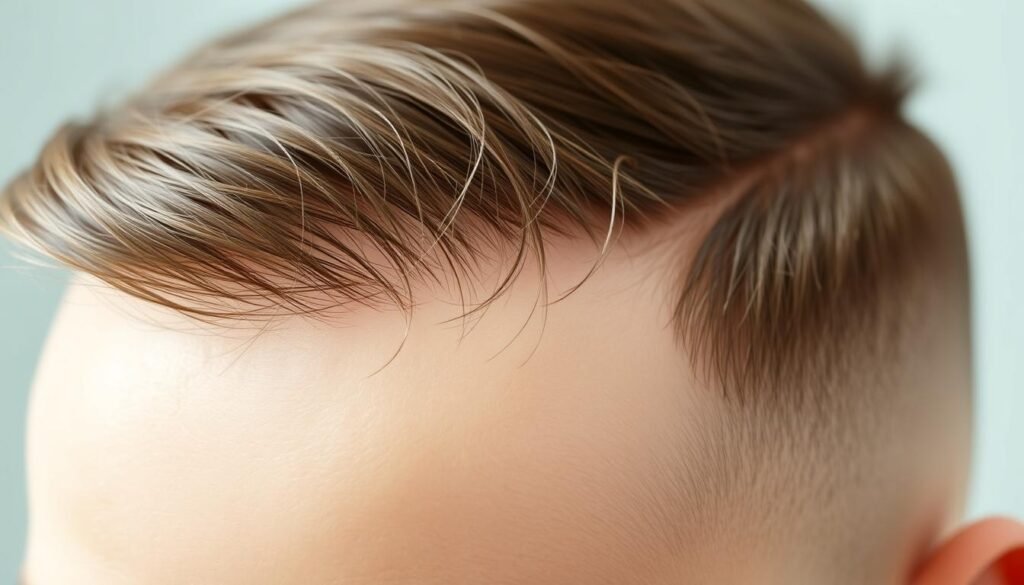
Ideal Candidates for Hair Transplant
Determining the ideal candidate for a hair transplant involves assessing several key factors. The patient should be medically fit with no serious health issues and have noticeable hair loss or balding areas.
A suitable candidate has sufficient donor hair density to cover the balding areas and is psychologically prepared for the procedure. Individuals with androgenetic alopecia typically respond well to transplant procedures.
“Realistic expectations about the results are crucial for candidate selection and satisfaction with outcomes.” Factors such as age, overall health, and the extent of hair loss
- Good general health without conditions that could impair healing.
- Stabilized hair loss or using medications to control ongoing loss.
- Psychological readiness to undergo the procedure.
Choosing the Right Hair Transplant Clinic in Al Ain
When it comes to hair transplantation in Al Ain, selecting a clinic that guarantees natural-looking results is paramount. Our medical team is dedicated to guiding you through every step of the process, even after surgery, to ensure you achieve the best possible outcome.
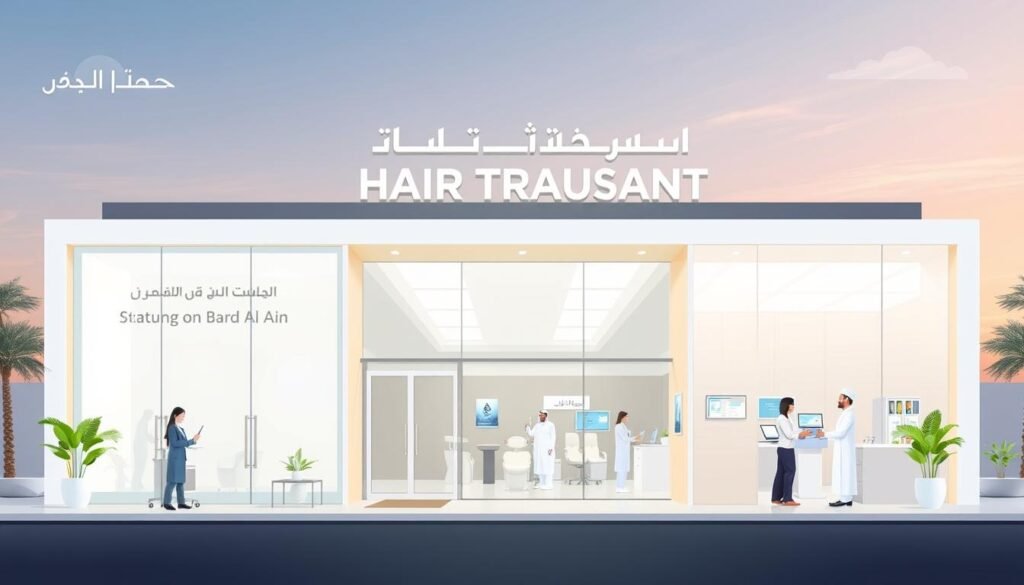
Questions to Ask Your Hair Transplant Surgeon
To ensure you’re in good hands, it’s essential to ask the right questions. Here are some key inquiries to make during your consultation:
- How many years of experience do you have specifically in hair transplantation procedures?
- What hair transplant techniques do you specialize in, and which would you recommend for my specific case?
- Can I see before-and-after photos of patients with similar hair loss patterns to mine?
- What results can I realistically expect given my donor hair availability and pattern of loss?
- Who performs the critical aspects of the procedure—the surgeon or technicians?
- What is your approach to designing natural-looking hairlines?
- What complications have you encountered in your practice, and how were they addressed?
- What is the total cost of the procedure, and what exactly does it include?
- What kind of follow-up care do you provide, and for how long after the procedure?
- What options do I have if I’m not satisfied with the results or if I continue to lose hair?
- How many transplant procedures do you perform monthly, and how much of your practice is dedicated to hair restoration?
- What measures do you take to ensure maximum graft survival and optimal results?
Alternatives to Hair Transplant
For individuals considering hair restoration, there are several alternatives to hair transplant surgery that can be effective. While hair transplant is a popular solution, it’s essential to explore other options before making a decision.
Non-Surgical Hair Restoration Options
Non-surgical hair restoration methods offer a range of treatments that can help address hair loss without the need for surgery. Some of these options include:
- Medication options like minoxidil (Rogaine) and finasteride (Propecia) that can slow hair loss and stimulate regrowth.
- Platelet-Rich Plasma (PRP) therapy, which utilizes the patient’s own blood components to stimulate hair follicles.
- Low-Level Laser Therapy (LLLT) devices that use red light to stimulate cellular activity and hair growth.
- Mesotherapy, involving injections of vitamins, minerals, and amino acids directly into the scalp.
Other alternatives include scalp micropigmentation, topical concealers and fibers, nutritional supplements targeting hair health, and hair systems or wigs for more extensive hair loss.
| Treatment | Description | Benefits |
|---|---|---|
| Minoxidil (Rogaine) | Topical application to stimulate hair growth | Slows hair loss, stimulates regrowth |
| Platelet-Rich Plasma (PRP) Therapy | Injections of platelet-rich plasma to stimulate hair follicles | Promotes hair growth, improves density |
| Low-Level Laser Therapy (LLLT) | Red light therapy to stimulate hair growth | Non-invasive, stimulates cellular activity |

Book Your Hair Transplant Consultation Today
Schedule a consultation to explore hair transplant options. To meet our specialist for your Best Hair Transplant in Al Ain, call us or visit our clinic as a walk-in patient.
- Receive personalized advice based on your hair loss pattern and goals.
- Discuss concerns and ask questions about the process.
- Understand side effects and the recovery transplant procedure.
Most clinics in Al Ain offer initial consultations at reduced rates or complimentary. Consult with a specialist to determine the best hair restoration approach.
Conclusion
With its permanent and effective results, hair transplantation in Al Ain offers a promising solution for hair loss. The variety of techniques available allows for customized approaches to address different types and patterns of hair loss. While the procedure requires an initial investment, the lifetime results make it cost-effective. Successful outcomes depend on choosing qualified surgeons and following aftercare instructions. Advances in technology continue to improve results, making the procedure more accessible and effective.

